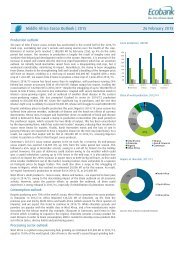www.ebook777.com
Make_Getting_Started_with_Processing_Second_Edition
Make_Getting_Started_with_Processing_Second_Edition
Create successful ePaper yourself
Turn your PDF publications into a flip-book with our unique Google optimized e-Paper software.
58 Getting Started with Processing<br />
<strong>www</strong>.<strong>ebook777.com</strong><br />
The == symbol compares the values on the left and right to test<br />
whether they are equivalent. This == symbol is different from the<br />
assignment operator, the single = symbol. The == symbol asks,<br />
“Are these things equal?” and the = symbol sets the value of a<br />
variable.<br />
It’s a common mistake, even for experienced programmers,<br />
to write = in your code when you mean to<br />
write ==. The Processing software won’t always warn<br />
you when you do this, so be careful.<br />
Alternatively, the test in draw() in can be written like this:<br />
if (mousePressed) {<br />
Boolean variables, including mousePressed, don’t need the<br />
explicit comparison with the == operator, because they can be<br />
only true or false.<br />
Example 5-11: Detect When Not<br />
Clicked<br />
A single if block gives you the choice of running some code or<br />
skipping it. You can extend an if block with an else block, allowing<br />
your program to choose between two options. The code<br />
inside the else block runs when the value of the if block test is<br />
false. For instance, the stroke color for a program can be white<br />
when the mouse button is not pressed, and can change to black<br />
when the button is pressed:



